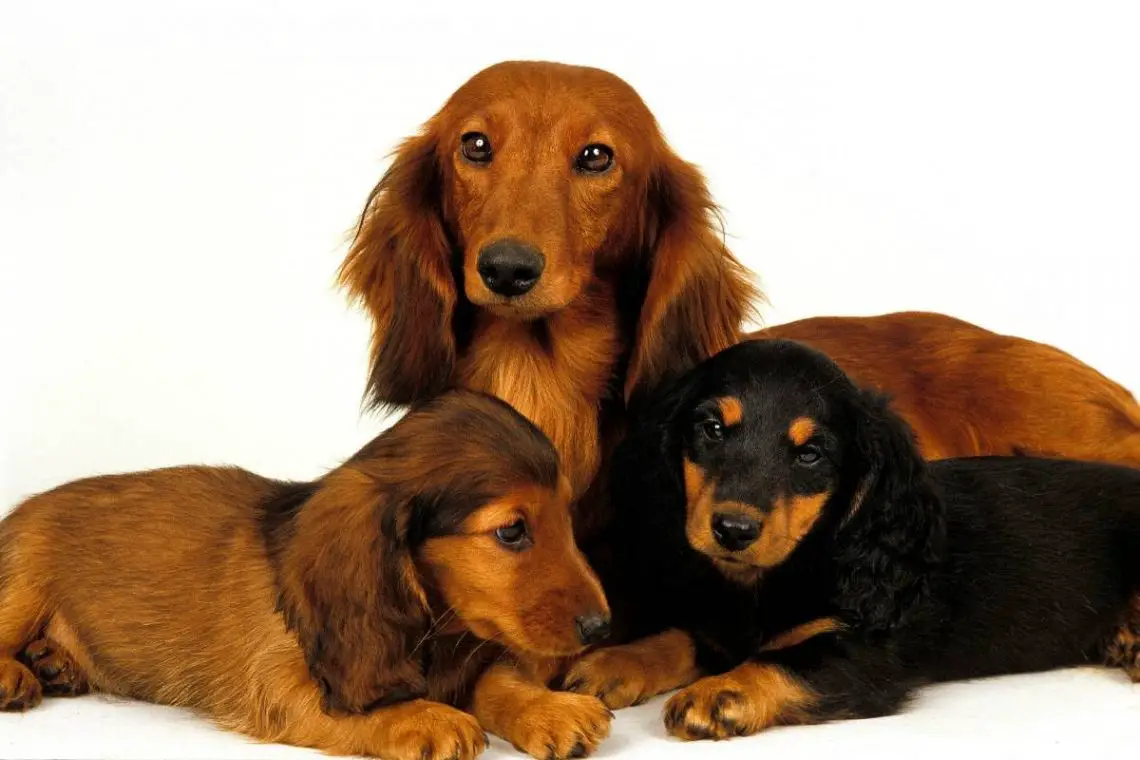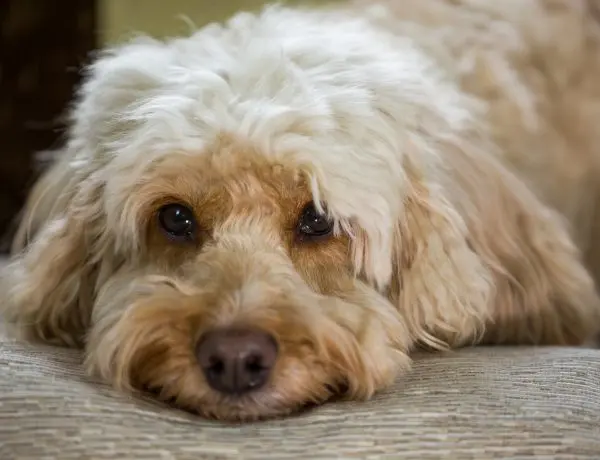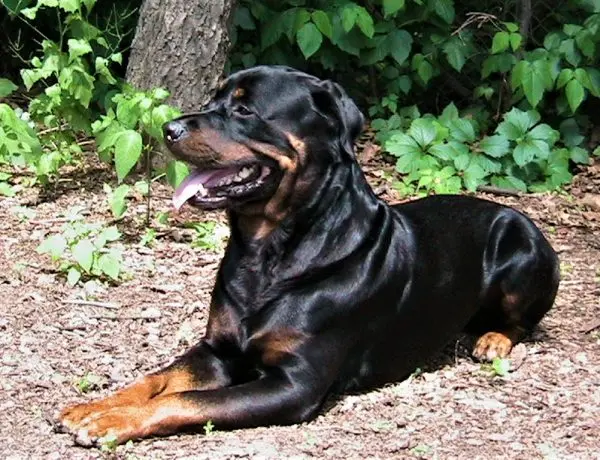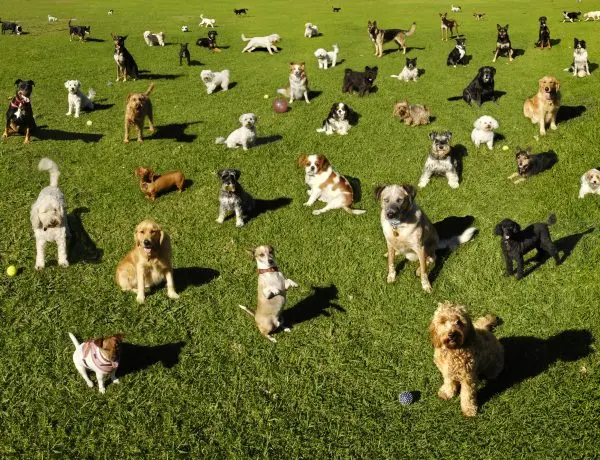There are hundreds of different dog breeds found throughout the world who each have their own look and personality. Many of these dog breeds share some similar traits, but others, like the Dachshund, have specific characteristics unique to their breed alone. It is important to know about these features of the purebred Dachshund because they may make or break the decision to bring this breed of dog home.
What should you know before deciding to add a Dachshund to your family? Important information to know about the purebred Dachshund includes:
- Physical appearance (including size and coat type)
- Health concerns
- Personality
- Energy level
- Trainability
Knowing what to expect when dealing with Dachshunds can determine if this is the right dog for your family and can help prevent surprises later on.
Table of Contents
History
Dachshunds (which is German for “badger dog”) were developed in Germany back in the 1800s. They blended various dogs together to create a dog with the physical abilities to dig out badger burrows and enough tenacity to fight those ferocious critters to the death. Knowing the original purpose of the breed helps explain their physical traits and many of their personality traits as well. Besides badgers, Dachshunds have also been used for hunting foxes and even wild boar.
Dachshunds were brought to the United States in the late 1800s and recognized by the American Kennel Club (AKC) in 1885. Their popularity grew quickly, and they have maintained that popularity in the US throughout the years. According to AKC, in 2019, they were the 11th most registered breed.
Dachshund Physical Traits
Dachshunds have unique physical characteristics that make them excellent at their original hunting job. Purebred Dachshunds indeed do not resemble any other dog breed, making them fascinating animals to own.
Size
According to the American Kennel Club (AKC), there are two sizes of Dachshunds. They are both small in stature, but one is considered a standard size, while the other is even littler and is called a miniature.
- Standard Dachshunds will weigh anywhere from 16 to 32 pounds when they are fully grown.
- Miniature Dachshunds come in at 11 pounds or lighter as adults, making them one of the lightest-weighing dog types.
There is a third size of Dachshund that is not official per the AKC standard. Some people call them “tweenies” because their weight is in-between the standard size and the miniature size, or 11 to 16 pounds.
In Germany, Dachshunds are split into three sizes, depending on their chest size. This is typically measured at about 15-18 months old. The recognized sizes there are standard, miniature, and Kaninchenteckel (known as the “tweenie” in the US).
No other dog is built quite the way they are, which is part of what makes them such a unique breed.
Head
Dachshunds are known to carry their heads held high, which gives them the appearance that they exude confidence. The United Kingdom Kennel Club (UK KC) expects the head to be held “proudly,” and the average Dachshund does not disappoint. Their facial expressions typically show they are alert and ready for anything that may cross their path. The head of the Dachshund is a peculiar shape compared to many other dog breeds. Rather than rounded, the face is tapered at the nose, giving it an almost triangular shape. This causes the snout to be elongated rather than closer to the face.
- Nose: Dachshunds were initially bred to be hunting dogs, so their noses play a significant role in their physicality. They first used their keen sense of smell to follow other animals’ scents, most often trailing after badgers. Even as pets, they still use their noses to recognize their family members’ scents and interact with other dogs.
- Eyes: The Dachshund’s eyes are almond-shaped and typically a darker color. The eyes say a lot about a creature, and the Dachshund’s eyes showcase its intelligence and perceptivity. Dachshunds are always vigilant about looking for potential threats, so they are quite observant, and their eyesight is keen.
- Ears: The ears hang down the sides of the head, rather than pointing out of the crown. Because the ears are long and their bodies are so low to the ground, the ears can often fold over onto themselves, which can cause a buildup of dirt, earwax, and other grime. Dachshund owners should make sure they are regularly cleaning their dog’s ears.
Body
- Torso: Perhaps the most recognizable feature of the Dachshund, the torso is long, lean, and muscular. The AKC standard calls for them to be “low to ground, long in body and short of leg with robust muscular development.” This characteristic causes Dachshunds to often be nicknamed “hot dogs” or “wiener dogs,” as the shape gives the impression of a sausage. This body style is required for a dog to successfully do the type of underground work that the Dachshund was bred for.
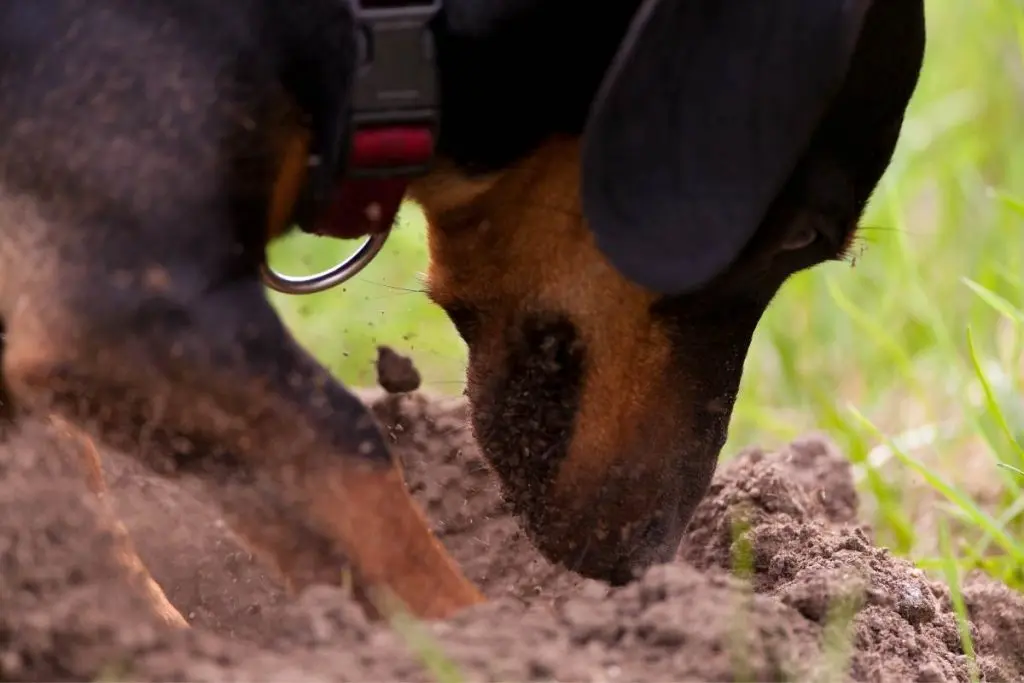
- Legs: The Dachshund’s legs must be strong enough to carry the weight of its long torso evenly. The front two legs are especially important, as they are the primary tools the Dachshund uses for digging. The rear legs are not as large or able as the front, but they are still useful for driving the dog forward and giving them the ability to move fluidly.
- Nails: The AKC standard calls for strong, short nails. Occasionally, with the right activity level and terrain, a Dachshund may naturally file their nails down on their own, but it is more likely that you will need to keep their nails short for them. This can be done with a grinding tool or nail clippers and should be done every 2-4 weeks.
- Tail: The Dachshund’s tail typically sticks straight out of the rear, without any sort of curls or kinks in it. It may raise slightly above the back or hang down between the legs, but it should not be so long that it gets in the way of their movement, nor should it be carried high over its back.
Coat
Within the Dachshund breed, there are three types of coat they can potentially have. This is perhaps the most significant difference between one Dachshund and the next because even though their body type and traits are the same, each coat style was developed initially from different breeds. Therefore, each coat type has some slightly different personality traits that tend to go with it.
Smooth Coat
In the United States, the most popular kind of Dachshund to own is the smooth-haired Dachshund. These dogs have a short coat that is smooth, sleek, and shiny. Their coat is short enough that they do not need to be regularly groomed other than a simple bath, nail trim, and ear cleaning.
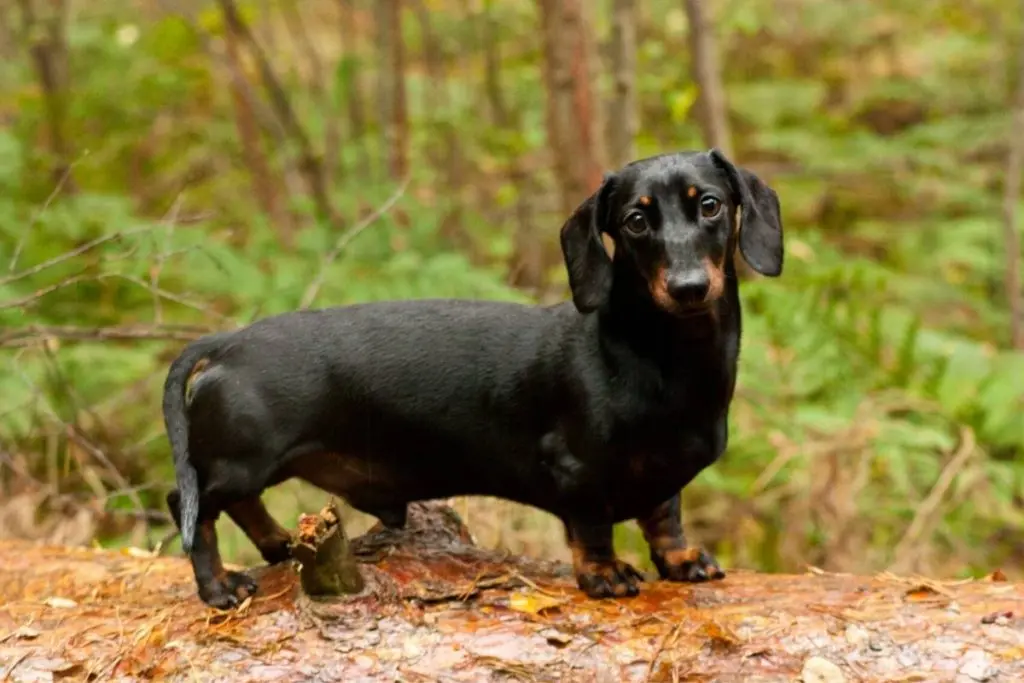
The short coat of the smooth Dachshund may not keep them completely warm. If they live in a colder climate, they will often need extra protection when going out into the wind and cold.
Smooth Dachshunds come in many different colors. They can be a single color over their whole body (most likely either red or cream) or be a mix of two colors. The two-colored Dachshunds can be black, chocolate, wild boar, gray, or fawn with tan or cream markings.
There are also a few patterns common with smooth Dachshunds.
- Dappled: These have a merle pattern where there are lighter-colored areas on their mostly dark body.
- Brindle: This pattern is where black or dark stripes cover the entire body, but they are sometimes only visible in the lighter colored areas.
- Piebald: This is a pattern where there are distinct patches of white amongst the other colors.
- Sable: This pattern is a dark overlay on a red dog.
The AKC and UK KC standards for Dachshunds’ coat color are a bit more rigid, and some of the colorings have specific requirements that go along with them, especially the piebald pattern. The Dachshund Club of America goes into more detail with the specifications of each color and pattern.
Wirehaired Coat
The wirehaired Dachshund is slightly different from the other two. As the name suggests, their coat is short, thick, and wiry, and can be rough to the touch. They usually have an undercoat with softer, thinner hairs that are spread throughout the body underneath the choppier top coat.
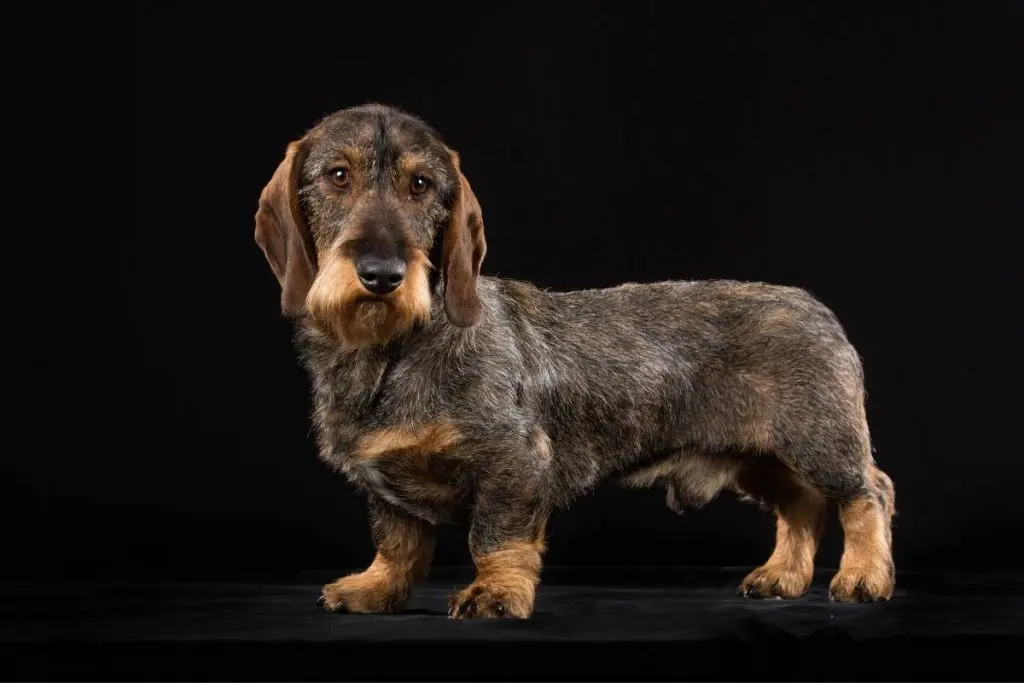
Wirehaired Dachshunds have the unique trait of a bushy beard and eyebrows, which the others do not have. These again may be coarse rather than smooth. The outer coat should not be too long or wavy.
This type of Dachshund does have one smooth area on its body: the ears. A wirehaired Dachshund’s ears are usually much smoother than the rest of their body, with short hair that is almost soft to the touch compared to the rest of the coat.
All of the patterns the smooth Dachshund can also be applied to the wirehaired. The most common colors of this type of the breed are several shades of red, a mixture of black and tan, and wild boar. The wild boar look most often appears on the wirehaired Dachshund and is a combination of black, brown, and gray.
Wirehaired Dachshunds came about by selectively breeding in various hard-coated terriers and wirehaired pinschers back in the 1800s.
Although personality traits are similar between all three coat variations, the wires are often reported as being more outgoing with people. Yet, they sometimes have a tendency to be more aggressive with other dogs.
Longhaired Coat
If searching for a dog with an elegant look, the longhaired Dachshund is a great choice. The coat on this dog is sleek and shiny like the smooth Dachshund but is lengthened and often has a bit of a wave to it.

The longhaired Dachshund’s coat should be the most prominent on the ears, the neck, and chest, and behind the legs on the rear. Their tail should also have long, silky hair and hang down slightly; this differs from the short, perky tail of the other two. This hair should be brushed often to help prevent tangles or matting.
The colors of the longhaired Dachshund are similar to those of the smooth. They can sport one color covering their whole body, a mixture of two, or any of the patterns that the smooth Dachshund could have.
The longhaired Dachshunds are thought to have either been developed by breeding them with various land and water spaniels back in the 1800s, or simply by selectively breeding the smooths with a slightly longer coat over time. Some people believe that the longhaired Dachshund has a gentler temperament than those of the smooth and wirehaired. For the most part, they appear to be relatively docile and calm for a hunting dog.
Health Concerns
Dachshunds are generally a healthy breed, with an average life span of 12 years and some living as long as 16 years! However, there are a few health issues common to the breed that you should be aware of.
The first is Intervertebral Disk Disease (IVDD), which results in slipped or ruptured disks. This problem is common to Dachshunds due to their long backs and the additional strain on their spinal cords. It is essential to keep your Dachshund at the proper weight and not allow them to become obese, as obesity can increase their chances of developing IVDD as well as diabetes and joint problems.
Other health issues sometimes found in the breed include cataracts, progressive retinal atrophy (PRA), heart disease, and hemangiosarcoma. Epilepsy is sometimes found in Dachshunds and Lafora disease, which is most common in the miniature wirehaired variety.
If you plan to purchase a Dachshund puppy, it is best to choose a breeder that tests their breeding stock for potential genetic health problems. You can search the Orthopedic Foundation for Animals website for the health testing that has been completed and registered with them for specific dogs you may be considering.
Dachshund Personality Traits
As with any other animal, every dog is different, and even in the same breed, their personalities will vary from dog to dog. A few common traits are seen in most Dachshunds, though, and are essential to recognize when considering bringing one home.
Overall, the Dachshund may be tougher than other hound breeds, because of their original use as hunters. They often have very loving and attentive personalities, especially when it comes to interacting with their owners. However, they possess a few traits that may deter potential families that want to adopt one.
Stubbornness
Dachshunds are infamous for believing they are the boss of their home. Because they were initially bred to work on their own while hunting, they are often extraordinarily independent and may take a while to warm up to new people.
This independence can make it challenging for Dachshunds to respect their owners. They will do as they please and might not listen to commands on the first few attempts, which can be frustrating for both the human and the dog as they struggle to connect with each other. It will take patience and consistency for your Dachshund to develop the proper level of respect for you.
Suspiciousness
Dachshunds are very defensive, so they can be wary of new things. They are known for having incredibly loud and long barks and will regularly use their voice to warn their owners of what they think is a potential threat.
These “threats” can include household noises such as the doorbell ringing or the garage door opening and closing, but may also be just plain silly, like balloons or toys. Whatever it may be, Dachshunds will charge toward it ready to fight. This can make taking them on walks especially tricky, as they have the potential to chase after any moving creature.
Dachshunds can also be suspicious of other people and dogs they do not know. They may even be cautious around their owner when they are first brought home and are learning their new surroundings. While this makes them excellent guard dogs, it can also pose a challenge for people who often have friends or other family members over that the Dachshund does not recognize.
The caution that Dachshunds take around people or other animals they do not recognize can become more intense if they feel they or the people they love are being threatened. It is essential to socialize your Dachshund to new people, dogs, and new environments.
Loyalty
Despite all of their gruffness, Dachshunds are incredibly loving and loyal creatures when it comes down to it. Once they know their family, they will long for attention and affection from their favorite people.
They do have a tendency to form an especially tight bond with one specific person, and will often stay close to that person to “protect” them from any harm—even if that harm is only perceived.
This can be especially problematic for homes with children, for if the Dachshund does not bond with the kids, the dog might respond with aggression. The potential for issues between little ones and Dachshunds is something to consider for families with children when thinking about bringing a Dachshund into their lives.
While the Dachshund’s loyalty can be charming, it may also sometimes extend so far that they crave the attention of their humans and will be upset if they do not receive it. If they are not met with that attention, or if their owners are often gone for extended periods, Dachshunds will have trouble coping.
Because of their separation anxiety, Dachshunds do not do well when left alone. When left by themselves, they may become destructive toward household or outside objects. Crate training and conditioning your dog to be comfortable alone for short periods of time can help with this issue.
Therefore, their owners must be around often to give them all the love and affection they could possibly want. If their humans have inconsistent work schedules or leave the house a lot for extended periods, a Dachshund may not be the best option.
Energy Level
If you are looking for a dog that will run around and play all day long, the Dachshund is an excellent choice. Although these little guys are small, they have loads of energy to spare and will expel it in any way they can, even if it means making a mess or getting into a fight.
All of that energy makes Dachshunds a lot of fun to have around. They love to play with their humans and want to be involved in everything they are doing to try and make a game out of it. They may want to help with chores or yard work and follow their owner around watching their every move.

Dachshunds love spending time outside as well. Because they were designed for burrowing, they may try to help with gardening by digging holes into the ground. They will also make sure the yard is entirely safe by sniffing out everything that has passed through.
The best way to help release some of this extra energy is by making time to play with and entertain them. They will enjoy chasing after balls and toys thrown for them and will run around all day long if they are allowed. Taking them on long walks is another excellent way to give them some activity. All of this playing will help prevent boredom, which can lead to destruction if it gets too bad.
This energy also makes it challenging to take Dachshunds on those lovely, long walks. At a moment’s notice, they could take off running, chasing something that caught their eye at that time. Fortunately, because they do not weigh a lot, they are relatively easy to restrain. Still, owners must be careful about paying attention to where the dog is going and what they are doing.
Trainability
One of the most important factors to know when deciding to adopt a dog is how easy it is to train them. Depending on where you get your Dachshund from, some may have already had basic training, but for the most part, they need to be taught how to behave appropriately around other dogs and people.
Dachshunds may be a bit of a challenge when it comes to training for a few reasons. Some people may not be willing to step up and take that challenge, which means a Dachshund would most likely not be a good fit. However, if someone can handle training with patience and calm demeanor, the end result can be very satisfying.
Intelligence
Dachshunds are known for being an intelligent breed. They are able to communicate to their humans precisely what they need and can, in turn, understand their human’s commands. When they make a mistake, they are also very quick to adapt, so they do the task correctly the next time.
They also have “street smarts” thanks to their badger-hunting origins. This means they have strong instincts when it comes to searching and sniffing out other creatures, and if challenged, will certainly fight back. Despite their diminutive stature, they are can occasionally become aggressive and may attack if they feel uncertain about a situation.
So, if Dachshunds are so intelligent and clever, why are they difficult to train? They seem to know how to adjust to new problems and take care of themselves. The truth of the matter is, while they are certainly smart enough to learn, they often must be convinced that it is something they WANT to do.
Short Attention Span
With so many exciting sights to see and items to play with, Dachshunds can easily become distracted and no longer care about what they are being asked to do. This can make training difficult because if there is something more exciting happening than what their owner is asking them to do, they will choose the fun option.
This stems back to their stubbornness. Dachshunds will do what they want when they want to and can be challenging to convince otherwise, so keeping their attention to train them can be tough.
The best way to encourage participation in training is by providing positive reinforcement such as praise and treats. Yelling at or berating a Dachshund is not effective, and may cause them to become aggressive in response.
Lauding good behavior will teach them that they will continue to be rewarded if they keep behaving well. Their adaptability instinct will kick in to help them quickly learn what behaviors are good and which ones are not.
Disinterest
Sometimes, no matter how hard their owner tries, Dachshunds simply will not care about learning or being trained. Sometimes this can be confused with their stubbornness, but it really just stems from disinterest in the activity.
This can make training extremely hard because they often ignore what they are being told to do. Their independent nature plays a large part in this. They believe they are their own boss, so if someone else is commanding them to do a task, they may not be interested. Some Dachshunds will even manipulate their owners into letting them do whatever they want.
While Dachshund owners should always reward good behavior rather than punish bad, they should also be very firm with their dogs to show them that they, the humans, are in charge. Only when the Dachshund understands this fact will they pay attention and actually do the task they are being told to do.
Final Thoughts
With all of these points to consider before adopting a Dachshund, it is essential to remember that at the end of the day, Dachshunds love their families immensely. While they may have grumpy attitudes, be frustrating to work with, and sometimes just plain annoying, they create a special bond with their humans and will do anything they can to protect them.
No matter what size they are or what style of coat they have, a Dachshund can make a great addition to many families and be a loyal companion for many years.

